Largest 10 Hindu Temples in the World
Temple is a building devoted to the worship of a god or gods for religious practice. A Hindu temple is a symbolic house, seat and body of divinity for Hindus. It is a structure designed to bring human beings and gods together, using symbolism to express the ideas and beliefs of Hinduism. Temples of Hindu deities exist not only in India but around the world. People of the whole world are surprised by seeing the ancient Hindu temples famous for their vastness and amazing architecture. These amazing structures have been built several hundred years ago without any mechanical support. The spiritual principles symbolically represented in Hindu temples are given in the ancient Sanskrit texts of India for example, Vedas and Upanishads, while their structural rules are described in various ancient Sanskrit treatises on architecture. Here we are telling you about the 10 largest Hindu temples present in the world.
1.Angkor Wat, Angkor
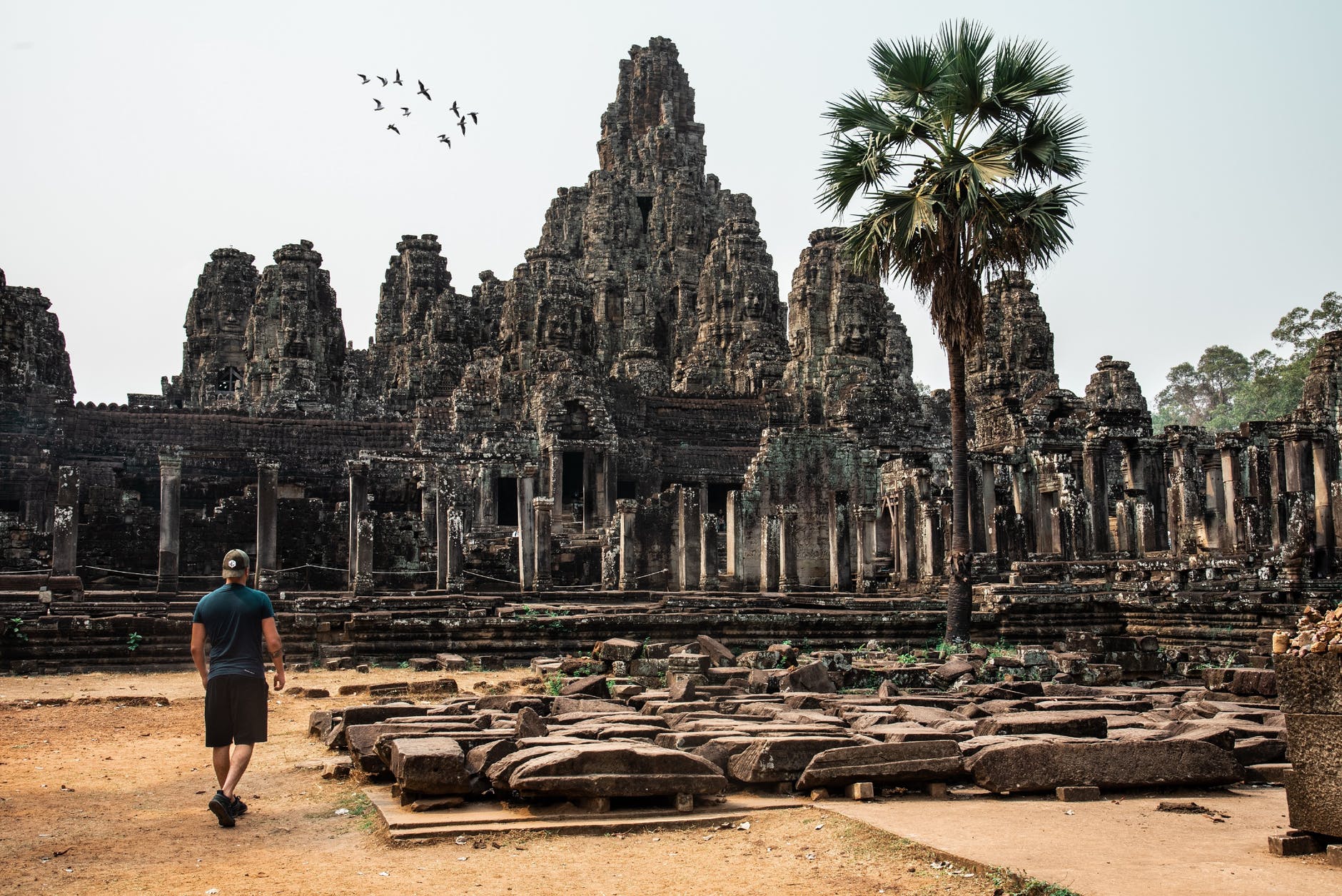
Angkor Wat is a temple complex at Angkor, Cambodia. It is the largest religious monument in the world, on a site measuring 162.6 hectares (1,626,000 m2; 402 acres) which was built for king Suryavarman II in the early 12th century as his state temple and capital city. The cultures of Southeast Asia reflect long periods of both Indian and Chinese influence. The temple complex contains numerous stone bas-reliefs in a highly refined style; many depict scenes from Hindu myth and legend. As the best-preserved temple at the site, it is the only one to have remained a significant religious center since its foundation — first Hindu, dedicated to the god Shri Vishnu, then Buddhist. The most important structure in Angkor Thom is the temple known as the Bayon, whose most distinctive feature is the enormous stone faces found atop its towers, each face carefully constructed from multiple blocks of stone.
On the island of Java, the massive Buddhist monument known as Borobudur testifies both to Indian influence and the persistence of local cultures. The structure of Borobudur was created in the century by rulers of the Sailendra dynasty. A vast structure built on an actual hill, its plan forms a mandala and it features no fewer than 72 Buddha figures set into individual domes. While temples in the form of mountains or mounds are a feature of Indian Buddhism, Borobudur is nevertheless unique and scholars speculate that its form and function are best explained by ties to native traditions. The decorations on the walls of the temple have a uniquely Hindu story telling characteristics. They have fables and myths pictures that tell of the temple’s origin in Hindu religion.
2.Swami narayan Mandir, New Jersey
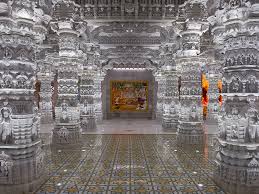
The BAPS Shri Swaminarayan Mandir in Robbinsville in Central New Jersey is a Hindu place of worship built by the BAPS Swaminarayan Sanstha and consecrated by Pramukh Swami Maharaj. The BAPS Swaminarayan Sanstha, led by Mahant Swami Maharaj, is a denomination of the Swaminarayan branch of Hinduism. One of the most interesting facts about the making of the Akshardham Temple in New Jersey is that stone marble was sourced from Europe and handcrafted in Rajasthan for years. An epitome of Indian culture, spirituality, and architecture, Swaminarayan Akshardham Temple is an abode of God built in 2005. The mandir is built of hand-carved Italian Carrara marble, Turkish limestone, and Indian pink stone. Over 8000 volunteers from all around the world were involved in the construction of intricately carved marble and sandstone structure of the temple. The central shrine holds the murtis of Swaminarayan and Gunatitanand Swami, together worshipped as Akshar-Purushottam Maharaj. Similarly, different shrines hold other murtis, including Radha & Krishna, Shiva & Parvati, Sita & Ram, Hanuman, Ganapati, and the lineage of BAPS gurus who are Swaminarayan’s spiritual successors. It was quite challenging to transport tons of marble from Europe to USA in a certain time frame. The mandir was constructed according to guidelines outlined in ancient Vedas, or Hindu scriptures. According to The Times of India, 2,000 artisans in Rajasthan are hand-crafting the temples in Italian and Rajasthani marble.
The finished pieces are then assembled in New Jersey by a team of master craftsmen. The main gate of the mandap, called Mayur Dwar, is a major attraction of the temple. The Mayur Dwar is meticulously adorned with 236 sculptures including peacocks, elephants, monks and devotees carved out of marble. The ornate pillars, panels, walls and ceilings depict stories of the Ramayana, the Mahabharata and ancient scriptures. This is beautiful both outside and inside. The temple is the first and only Swaminarayan temple outside India to have the twin form of Nar Narayan as central deities. It is also one of the first in the US to have domes. The architecture and intricate marble carvings were absolutely beautiful. Visiting this temple is a truly unique experience. The temple campus sprawls over 160 acres. A total of 4.7 million man hours spent by craftsmen and volunteers of all ages went into the making of the largest Hindu temple in USA, which is apparently not visible to the naked eye. A seat of spirituality, divinity, Hinduism and humanitarianism, the temple opened its door to devotees. It is made of chiseled Italian marble, this New Jersey Indian temple is a wonder in itself.
3.Ranganathaswamy Temple, Thiruchirapalli
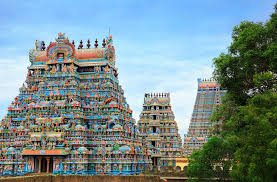
Srirangam temple is often listed as the largest functioning Hindu temple in the world. The temple, located in Tamil Nadu, occupies an area of 156 acres (631,000 m²) with a perimeter of 4,116m (10,710 feet) making it the largest temple in India and one of the largest religious complexes in the world. The Sri Ranganathaswamy Temple is one of the most distinguished and captivating Hindu temples in the world. This temple is considered to be the world’s largest functioning Hindu temple and the largest Temple in India. The temple houses the tallest gopuram or temple tower across South India. Located in Srirangam in Tiruchirapalli, Tamil Nadu, the magnificent Ranganathaswamy Temple is dedicated to Lord Ranganatha, a form of Lord Vishnu in a reclining pose. This temple has 108 deities displaying different forms of Vishnu.
The largest functioning Hindu temple is spread over an area of about 155 acres within a perimeter of 4 km. The temple houses the ancient inscriptions not just in Tamil, but also in other languages like, Sanskrit, Telegu, Marathi, Oriya and Kannada. The temple is enclosed by seven concentric walls with a total length of 32,592 feet or over six miles. These walls are enclosed by 21 Gopurams. The Ranganathanswamy Temple complex with 49 shrines, all dedicated to Lord Vishnu, is so huge that it is like a city within itself. However, the entire temple is not used for the religious purpose, the first three out of seven concentric walls are used by private commercial establishments such as restaurants, hotels, flower market, and residential homes. The temple was awarded with UNESCO Asia Pacific Award for Cultural Heritage Conservation Program in the year 2017 for the category ‘Award of Merit’. The annual 21 days festival attracts more than 1 million visitors every year. This is one of the must visit festivals in south India. Another interesting fact about the temple is that the walls of the temple complex are painted with exquisite paintings using herbal and vegetable dyes.
- Chhatarpur Temple, New Delhi
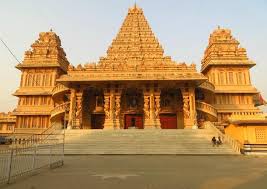
Commonly known as Chhatarpur Mandir, the Shree Adya Katyayani Shaktipeeth Mandir is nestled amidst the beautiful surroundings of the historical Mehrauli area in south Delhi, barely 4 kilometres from the Qutub Minar. this grand temple is dedicated to goddess Katyayani. It is also counted among the heritage sites of South Delhi. Spread over an area of about 70 acres, the temple features separate as well as shared areas dedicated to each deity divided into three complexes. There are captivating idols of deities like Katyayani, Laxmi-Ganesh, Shiva-Parvati, and Hanuman. It is like a marble art coming alive and is a modern mix of both northern and southern architectures. This temple was considered as the biggest temple in India and second largest in the world, before the Akshardham Temple was created in 2005 in Delhi. Thousands of devotees assemble here during festivals of Dussehra, Mahashivratri and Janmashtami, when special pujas and grand celebrations.
In the courtyard of the temple is a holy peepal tree where people tie threads for wish fulfilment. The temple was established in 1974, by Baba Sant Nagpal ji, who died in 1998. His samadhi shrine lies in the premises of the Shiv-Gauri Nageshwar Mandir within the temple complex. This temple is totally constructed from marble and on all the facets there is jaali (perforated stone or latticed screen) work. It can be classified a vesara style of architecture. Katyayani is one of the incarnations of Goddess Durga, also known as Parvati or Lalitha, the wife of Lord Shiva and has the following story as the background. There was a Rishi named Katyayan who worshipped Durga devi and asked her for a boon that she be born as his daughter. Devi got pleased and fulfilled his wish. In this Avtaar, she killed Mahishasur, the demon. The idol of Devi is depicted as golden complexioned and carrying various weapons in her hand for destruction of evil.
5.Swaminarayan Akshardham ,New Delhi
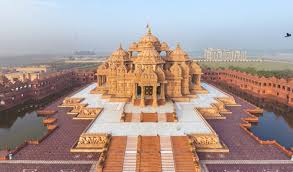
Akshardham is a Hindu temple complex in Delhi, India. Also referred to as Delhi Akshardham or Swaminarayan Akshardham, the complex displays millennia of traditional Indian and Hindu culture, spirituality, and architecture. The building was inspired and moderated by Pramukh Swami Maharaj, the spiritual head of the Bochasanwasi Shri Akshar Purushottam Swaminarayan Sanstha, whose 3,000 volunteers helped 7,000 artisans construct Akshardham. The temple was officially inaugurated on 6 November, 2005. The construction of Akshardham Complex was completed in just five years with the efforts of Bochasanwasi Shri Akshar Purushottam Swaminarayan Sanstha (BAPS) along with the help of thousands of artisans and BAPS volunteers. The temple is spread over 83,342 square feet area. It consists of 350 feet long, 315 feet wide and 141 feet high monuments, which are very attractive. The structure of the temple was designed in such a way that it can last for at least 1000 years more.
Akshardham Temple comprises 200 sculptured stone figures of India’s sages, monks, Acharyas and divine incarnations. It also consists of 234 ornately carved pillars, 9 ornate domes, Gajendra Pith and 20,000 statues of divine figures of India. Akshardham Temple is surrounded by Narayan Sarovar, which is a lake and carries water from 151 lakes in India. There are 108 faces of cows placed along the lakes which represent 108 Hindu deities. It has a 3,000-feet-long orbital path for Parikrama made up of red stones brought from Rajasthan. There is also an exquisite garden in the Akshardham temple complex in the shape of lotus and therefore is also, known as the Lotus Garden. The magnificent musical fountain show of this beautiful temple is the centre of attraction for the audience. Another interesting fact about Akshardham temple is that there are 10 gates, which represents the 10 directions according to Vedic literature. In the Akshardham temple complex, there is a Yagnapurush Kund which is the largest yagna kund in the world. In the temple premises there are green lawns which are collectively known as Garden of India or Bharat Upavan. The temple has 11 feet high beautiful statue of Lakshmi Narayan and other statues of Shiva Parvati, Radha Krishna and Sita Ram within the memorial.
6.Besakih Temple, Bali, Indonesia
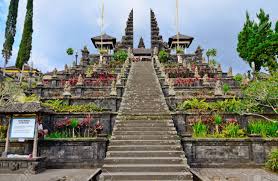
Besakih Temple is a pura complex in the village of Besakih on the slopes of Mount Agung in eastern Bali, Indonesia. It is known as and accepted as Bali’s Mother Temple for more than a thousand years. It is the most important, the largest and holiest temple of Hindu religion in Bali, and one of a series of Balinese temples. Perched nearly 1000 meters up the side of Gunung Agung, it is an extensive complex of 23 separate but related temples with the largest and most important being Pura Penataran Agung. The temple is built on six levels, terraced up the slope. The entrance is marked by a candi bentar (split gateway), and beyond it the Kori Agung is the gateway to the second courtyard. At least 70 celebrations take place at Besakih every year, as each shrine has its own anniversary. Its high location offers spectacular countryside views with rice paddies, hills, mountains, and streams. visiting the temple sanctuaries of Besakih is a special pilgrimage.
Mount Agung’s position gives it an almost mystical quality. Several stairs lead up to the sacred mountainside, leading to temples that vary by type, status, and function. Pura Penataran Agung has white banners for Shiva, the destroyer; Pura Kiduling Kreteg features red banners for Brahma, the creator; and Pura Batu Madeg represents Vishnu, the preserver, with its black banners. Pura Pasimpangan lies on the downstream side (on the east of the main street), while Pura Pangubengan can be found upstream. A series of eruptions of Mount Agung in 1963, which killed approximately 1,700 people, also threatened Pura Besakih. The lava flows missed the temple complex by mere meters. This complex of Hindu temples is the largest, holiest and most important on the island and miraculously survived the catastrophic volcanic eruption. The location of Mount Agung gives the temple complex a mystical quality and for the local Balinese, visiting this temple sanctuary is a truly special pilgrimage. It serves as a popular destination for visitors to Bali and as a place of prayer for local Hindu people.
7.Belur Math, West Bengal
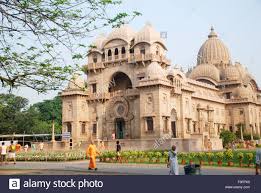
Mutt is the headquarters of the Ramakrishna Math and Mission, founded by Swami Vivekananda, a chief disciple of Ramakrishna Paramahamsa. It is located on the west bank of Hooghly River, Belur, West Bengal, India and is one of the significant institutions in Calcutta. This temple is the heart of the Ramakrishna Movement. The temple is notable for its architecture that fuses Hindu, Christian and Islamic motifs as a symbol of unity of all religions. Swami Shivananda said about the earlier temple echoes in our ears: ‘This is our shrine. Sit here for a while and do japa. Sri Ramakrishna is present here fully awakened; he sees and hears everything; … pray to him for bhakti, mukti, wisdom, power of discrimination, dispassion, liberation or money, power, pleasures of life or anything; you will get whatever you want.’ Even people not interested in religion come here for the peace it exudes. The serene campus of belur math on the Ganga includes temples dedicated to Sri Ramakrishna, Sri Sarada Devi and Swami Vivekananda, in which their relics are enshrined, and the main monastery of the
Ramakrishna order. The place has been sanctified by the stay of Swami Vivekananda and most of the monastic disciples of Sri Ramakrishna who spent several years here. Holy Mother Sri Sarada Devi also visited this place on several occasions. The room in which Swamiji attained Mahasamadhi has been preserved here. This place of religious importance is visited by people from all over India and abroad. The main gate of belur math leads to the Ramkrishna Sarada Mandir. belur math has also provided other things such as an art college, an industrial school and charitable dispensary. belur math is free from bigotry and sectarian rational and is modern in outlook. Belur math has an amazingly big prayer hall, where you can find the awesome statue of Ramakrishna. This international tourist attraction place is based on the principle of religious fraternity, as was advocated by Ramakrishna Paramhansa. This is also reflected in the architectural design of Math, which exhibits a blend of temple, church and mosque patterns.
- Nataraja Temple, Chidambaram
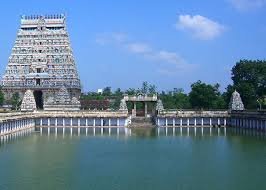
The architecture of the temple represents the link between arts and spirituality. Thillai Natarajah Temple, Chidambaram – Chidambaram Thillai Natarajar-Koothan Kovil or Chidambaram temple is a Hindu temple dedicated to Lord Shiva located in the centre of the temple town of Chidambaram, Tamil Nadu in east-central South India. Chidambaram is a temple complex spread over 40 acres (160,000 m2) in the heart of the city. The Cholas considered Lord Shiva as Nataraj as their family deity. The temple has five main Halls or Sabhas namely the Kanaka Sabha, the Cit Sabha, Nritta Sabha, Deva Sabha and Raja Sabha. This temple is located at the Center Point of world ‘s Magnetic Equator. amoung the “Pancha bootha” temples, Chidambaram denotes the Skies. Kalahasthi denotes Wind. Kanchi Ekambareswar denotes land. All these 3 temples are located in a straight line at 79 degrees 41 minutes Longitude. This can be verified. An amazing fact & astronomical miracle.
It is truly a large temple which is completely used for religious purpose. Temple roof is made of 21600 gold sheets which denotes the 21600 breaths taken by a human being every day (15 x 60 x 24 = 21600). These 21600 gold sheets are fixed on the “Vimanam” (Roof) using 72000 gold nails which denote the total no. of Nadis (Nerves) in the human body. “Ponnambalam ” is placed slightly tilted towards the left. This represents our Heart. To reach this, we need to climb 5 steps called “Panchatshara padi ” “Si, Va, Ya, Na, Ma ” are the 5 Panchatshara mantras. There are 4 pillars holding the Kanagasabha representing the 4 Vedas. Kalasas on the Golden Roof represent the 9 types of Sakthi or Energies.The 6 pillars at the Artha Mantapa represent the 6 types of Sashtras. The 18 pillars in the adjacant Mantapa represents 18 Puranams. The main complex to Lord Shiva Nataraja also contains shrines to deities such as Sivakami Amman, Ganesh, Murugan and Vishnu in the form Govindaraja Perumal.
9.Prambanan, Yogyakarta
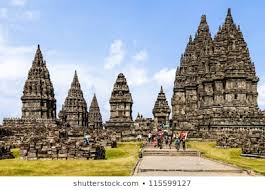
Rara Jonggrang is a 9th-century Hindu temple compound in Central Java, Indonesia, dedicated to Shiva. It also houses shrines of Vishnu, Brahma and their consorts. The temple compound is located approximately 17 kilometres (11 mi) northeast of the city of Yogyakarta on the boundary between Central Java and Yogyakarta provinces. The temple compound, a UNESCO World Heritage Site, is the largest Hindu temple site in Indonesia, and one of the biggest in Southeast Asia. It is characterized by its tall and pointed architecture, typical of Hindu temple architecture, and by the towering 47-metre-high (154 ft) central building (Lord Shiva shrine) inside a large complex of individual temples. Prambanan attracts many visitors from across the world. The complex is laid out in the form of a mandala, and features the towering, broad spires that are typical of Hindu temple architecture, and represent Meru, the holy mountain where the gods live. Originally there were 240 temples in the complex but many of them have deteriorated or been looted leaving just scattered stones.
The three main inner shrines are dedicated to Brahma the Creator, Vishnu the Keeper and Shiva the Destroyer. The three towers cut a striking figure in any conditions, but are perhaps most breathtaking when lit up at night. The Shiva temple dedicated to Shiva the Destroyer is the tallest and largest structure in Prambanan complex, it measures 47 meters (154 feet) tall and 34 meters (111 feet) wide. The other name of this temple is the Lorojonggrang temple. Prambanan attracts many visitors from around the world. Prambanan Temple Compounds comprises of two groups of buildings which includes Loro Jonggrang, Sewu complexes, Lumbung, Bubrah and Asu (Gana). The 508 stone temples of various shapes and sizes are either in a complete and preserved condition or have been retained as ruins. This site includes all elements necessary to express its exceptional significance and is well maintained. There are no threats of development or neglect; however the area is prone to natural threats such as earthquakes and volcanic eruptions. This temple has been revitalized and today is widely regarded as the most beautiful and graceful Hindu temple in Indonesia.
10.Brihadisvara Temple, Thanjavur
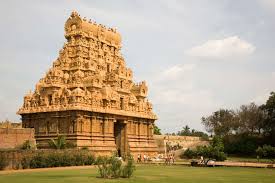
The temple, which is also called as Brihadeshwara Temple and RajaRajeswara Temple Rajarajeswaram, is among the largest temples of the country. It was the Marathas who gave it the name Brihadeeshwara or the Great Ishwara.The temple has the world’s tallest vimanam (temple tower) and its Kumbam (the structure on the top) weighs approximately 80 tons. The temple is said to have a huge cap stone on top of it, The Garbhagriha where the Shiva lingam is located is said to generate large amount of electromagnetic energy. The 80 tonne stone acts a repulsive force and channels the energy to the inner areas of the temple to sustain its piousness and divinity. The positive energy radiant within in the temple structure is said to have a calming, soothing effect both mentally and physically on the devotees. The structure is a proof of wealth, artistic expertise and power of the Chola kingdom. The temple has a huge statue of Nandi (sacred bull) at the entrance. The statue is carved out of a single rock and weighs around 20 tons. The Lingam inside the temple is 3.7 meters tall. Brihadeeswarar temple is the first complete granite temple in the world. Around 60,000 tons of granite is said to be used to build the temple.
A long associated myth with this temple is that the shadow of the main structure does not fall on the ground. There is also evidence that the temple was a platform for talented dancers to showcase their talent. The inscriptions also mention the different kinds of jewels used in the period. Each of these jewels are mentioned in detail. A total of twenty three different types of pearls, eleven varieties of diamonds and rubies are mentioned in these inscriptions. We can’t even imagine how this would have made possible in those days without any special equipment. The big Tanjavur temple is said to have more than hundred underground passages that connects to various other places. Nowadays, most of the passages are sealed. In the earlier days, the passages were used by sages, Kings and Queens to roam about different temples and places, especially during auspicious festivals like Deepavali, Maha Shivarathri and Makar Sankranti.
